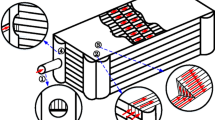Abstract
Low temperature corrosion characteristics on flue gas heat exchanger surfaces are crucial for reliability of equipment operation. Reasonable fin structure and accurate prediction of sulfuric acid vapor can understand corrosion characteristics and enhance performance. In this paper, a coupling numerical model is adopted to predict the condition of sulfuric acid vapor on heat exchanger surfaces. A rectangular type finned tube is employed to analyze the effect of operating parameters on sulfuric acid condensation and corrosion. The results show that fin regions with higher temperature have higher acid solution concentration. Although the increases of water vapor concentration could result in increase of deposition, the increase of flue gas temperature will reduce corrosion risk. The important is the rectangular fin can avoid high corrosion risk on its leading edge. Therefore, rectangular fin may be considered as an alternative scheme without reducing heat transfer performance and elongating the lifespan of individual fin.












Similar content being viewed by others
References
E. Abel, The vapor phase above the system sulfuric acid-water. J. Phys. Chem. 50(3), 260–283 (1946). doi:10.1021/j150447a011
R.W. Wilson, F.P. Stein, Correlation of sulfuric acid-water partial pressures. Fluid Phase Equilib. 53, 279–288 (1989). doi:10.1016/0378-3812(89)80096-2
F. Pessoa, C.S. Campos, A. Uller, Calculation of vapor–liquid equilibria in aqueous sulfuric acid solutions using the UNIQUAC equation in the whole concentration range. Chem. Eng. Sci. 61(15), 5170–5175 (2006). doi:10.1016/j.ces.2006.03.026
Vorgelegt, V., Condensation of water vapor and acid mixtures from exhaust gases, Dr. Ing Dissertation, Technical University of Berlin, 2004
H. Han, Y. He, W. Tao, A numerical study of the deposition characteristics of sulfuric acid vapor on heat exchanger surfaces. Chem. Eng. Sci. 101, 620–630 (2013). doi:10.1016/j.ces.2013.07.024
Y.-C. Wang, G.-H. Tang, Acid condensation and heat transfer characteristics on H-type fin surface with bleeding dimples and longitudinal vortex generators. Chin. Sci. Bull. 59(33), 4405–4417 (2014). doi:10.1007/s11434-014-0564-3
X. Zhao et al., Numerical investigation of heat transfer and erosion characteristics for H-type finned oval tube with longitudinal vortex generators and dimples. Appl. Energy 127, 93–104 (2014). doi:10.1016/j.apenergy.2014.04.033
Y. Wang, G. Tang, Prediction of sulfuric acid dew point temperature on heat transfer fin surface. Appl. Therm. Eng. 98, 492–501 (2016). doi:10.1016/j.applthermaleng.2015.12.078
Author information
Authors and Affiliations
Corresponding author
Rights and permissions
About this article
Cite this article
Fu, L., Liu, P. & Li, G. Numerical Investigation on the Low Temperature Corrosion Characteristics of Flue Gas Heat Exchanger. J Fail. Anal. and Preven. 17, 1164–1173 (2017). https://doi.org/10.1007/s11668-017-0354-8
Received:
Published:
Issue Date:
DOI: https://doi.org/10.1007/s11668-017-0354-8




